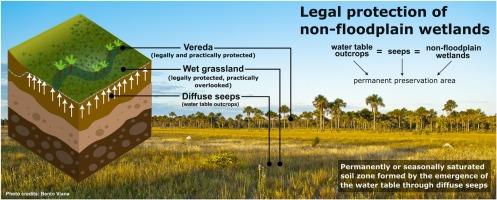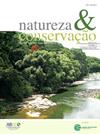法律保护,实际上被忽视:塞拉多非洪泛平原湿地保护中对弥漫性渗漏的忽视
IF 3.5
2区 环境科学与生态学
Q1 BIODIVERSITY CONSERVATION
引用次数: 0
摘要
巴西在法律上保护渗漏(葡萄牙语为olhos d ' água)——被定义为地下水位的自然露头,即使是间歇性的——作为永久保护区在全球脱颖而出。然而,这种保护并不适用于非洪泛平原湿地,如campos úmidos和campos de murundus,它们是由弥漫性渗漏形成的,在调节水循环和储存碳方面发挥着关键作用。由于缺乏将科学理解与法律定义联系起来的明确术语,这些生态系统经常被排除在保护工作之外。在塞拉多,扩散渗漏对水安全至关重要,这种脱节阻碍了有效的保护。根据巴西现有的法律框架,我们认为将非洪泛平原湿地视为渗漏形成的生态系统将加强保护和执法。我们敦促科学家、土地所有者、环境顾问和政府机构在描述这些湿地时采用“渗水”一词,确保它们在现行立法下被认定为永久保护区。本文章由计算机程序翻译,如有差异,请以英文原文为准。

Legally protected, practically overlooked: The neglect of diffuse seeps in the conservation of Cerrado non-floodplain wetlands
Brazil stands out globally for legally protecting seeps (olhos d’água, in Portuguese) — defined as natural outcrops of the water table, even if intermittent — as Permanent Preservation Areas. However, this protection does not extend to non-floodplain wetlands, such as campos úmidos and campos de murundus, which are formed by diffuse seeps and play critical roles in regulating the hydrological cycle and storing carbon. These ecosystems are frequently excluded from conservation efforts due to the lack of clear terminology connecting scientific understanding with legal definitions. In the Cerrado, where diffuse seeps are essential for water security, this disconnect hinders effective protection. Drawing on Brazil’s existing legal framework, we argue that recognizing non-floodplain wetlands as seep-formed ecosystems would strengthen conservation and enforcement. We urge scientists, landowners, environmental consultants and government agencies to adopt the term “seeps” when describing these wetlands, ensuring they are recognized as Permanent Preservation Areas under current legislation.
求助全文
通过发布文献求助,成功后即可免费获取论文全文。
去求助
来源期刊

Perspectives in Ecology and Conservation
Environmental Science-Nature and Landscape Conservation
CiteScore
7.80
自引率
4.30%
发文量
46
审稿时长
59 days
期刊介绍:
Perspectives in Ecology and Conservation (PECON) is a scientific journal devoted to improving theoretical and conceptual aspects of conservation science. It has the main purpose of communicating new research and advances to different actors of society, including researchers, conservationists, practitioners, and policymakers. Perspectives in Ecology and Conservation publishes original papers on biodiversity conservation and restoration, on the main drivers affecting native ecosystems, and on nature’s benefits to people and human wellbeing. This scope includes studies on biodiversity patterns, the effects of habitat loss, fragmentation, biological invasion and climate change on biodiversity, conservation genetics, spatial conservation planning, ecosystem management, ecosystem services, sustainability and resilience of socio-ecological systems, conservation policy, among others.
 求助内容:
求助内容: 应助结果提醒方式:
应助结果提醒方式:


